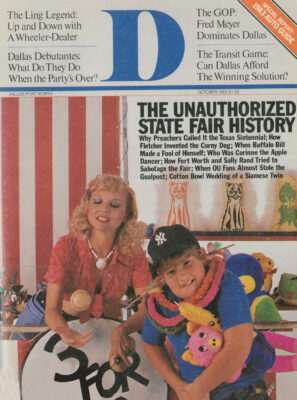THERE IS a special brand of churning, haunting music reserved for deserted fair-grounds. When supporters of the Dallas Symphony and the Dallas Museum of Fine Arts won their fight to move downtown, many heard the calliope gearing up at Fair Park. All at once the title “Arts District” slipped through the gates of the park and settled downtown, leaving many people doubtful about the future of Dallas’ Centennial-year pride and joy.
But with the passage of the $18 million bond issue for park renovations has come a new wave of optimism. Plans are being drawn; support is being pledged. Some are calling it renaissance time at Fair Park.
One look at the park’s roster of tenants shows good reason for renaissance: Dallas Historical Society, Dallas Civic Garden Center, Dallas Aquarium, The Science Place, Dallas Museum of Natural History, The Age of Steam Railroad Museum and The Shakespeare Festival, State Fair Music Hall and the Daughters of the American Revolution House. Fair Park is the only complex in the country with a major football stadium, a performing arts center and five museums in one two-mile area.
Another look at the buildings in Fair Park proves the treasure Dallas has gathered on 277 acres of her east side. Many of the buildings are examples of art deco at its best.
When George Dahl went to work in 1935 as Centennial architect, he had less than a year to design and complete construction of the entire Fair Park complex. “Nobody knew how we were going to do it,” he says, “but the people said ’we’ll have a celebration, and it’ll be great for the state.’ No one realized how much time it would take.”
By June 6, 1936, when the Dallas Centennial celebration began, the 50 permanent or semipermanent buildings were completed.
The architecture wasn’t the rugged frontier style most people expected. The city wanted to avoid a stereotypically Texan look but still convey the Southern flavor of the area. The style was not yet known as art deco.
Donald Barthelme, father of the Houston author, was in charge of the architectural commission for the Hall of State. He constructed it in the shape of an inverted “T.” The story of Texas history is represented in architectural materials and decorative art work. Five double doors of bronze and plate glass lead into the building and are decorated with symbols of industry and agriculture. Above the entrance is the Tejas warrior, a great bronze statue set before a blue tile backdrop representing-you guessed it -the Texas bluebonnet.
But the director of the Hall of State, John Crane, says Fair Park can’t live on an architectural reputation alone. “With the new Arts District and all the newcomers to Dallas, there are many whose attention is drawn first downtown; they don’t know enough about the history of Fair Park to want to conserve her. For that reason, we’re thinking about the future, not survival.”
Preservation is of particular importance in the case of the Hall of State, for in the cramped basement of the building is the Dallas Historical Society and an estimated $80 million worth of Texas artifacts and documents. The historical society has the story of early Dallas not shown anywhere else, including manuscripts about the Texas revolution, rare books and a large 19th-century photo collection.
Except for limited exhibits in the few showcases upstairs, most treasures go unseen by the public. There is no space.
Seven-hundred-and-fifty-thousand dollars of the bond money will go to the Hall of State for restoration of the art inside, improvements in storage, processing and conservation areas of the library, archives and museum divisions and installation of a kitchen and a library reading room. Society chief curator Conover Hunt Jones says she hopes the money will also provide “seeds to generate more money from private investors.”
Some of the other changes taking place at Fair Park include space shuffling: The Science Place will take over the Dallas Museum of Fine Arts building, and the State Fair Music Hall will hold additional performances when the symphony moves to its new hall. The Museum of Natural History is conducting a feasibility study for a fund drive to build a 30,000-square-foot building for exhibitions. A group is also forming to provide private funds for the construction of a new aquarium.
As for the Sesquicentennial, Chris Semos, chairman of the Texas Sesquicen-tennial Committee, says that, though the decision is not final, it is likely that instead of one large celebration in 1986, Dallas will be host to one of several, held at different times throughout the state.
But State Fair director Wayne Gallagher still plans a Texas-sized celebration at Fair Park for the state’s 150th birthday: “We fully anticipate that the celebration will be the biggest in the state – there were other celebrations in 1936, but ours was the biggest. It will be again.”
Related Articles

Arts & Entertainment
VideoFest Lives Again Alongside Denton’s Thin Line Fest
Bart Weiss, VideoFest’s founder, has partnered with Thin Line Fest to host two screenings that keep the independent spirit of VideoFest alive.
By Austin Zook

Local News
Poll: Dallas Is Asking Voters for $1.25 Billion. How Do You Feel About It?
The city is asking voters to approve 10 bond propositions that will address a slate of 800 projects. We want to know what you think.

Basketball
Dallas Landing the Wings Is the Coup Eric Johnson’s Committee Needed
There was only one pro team that could realistically be lured to town. And after two years of (very) middling results, the Ad Hoc Committee on Professional Sports Recruitment and Retention delivered.


